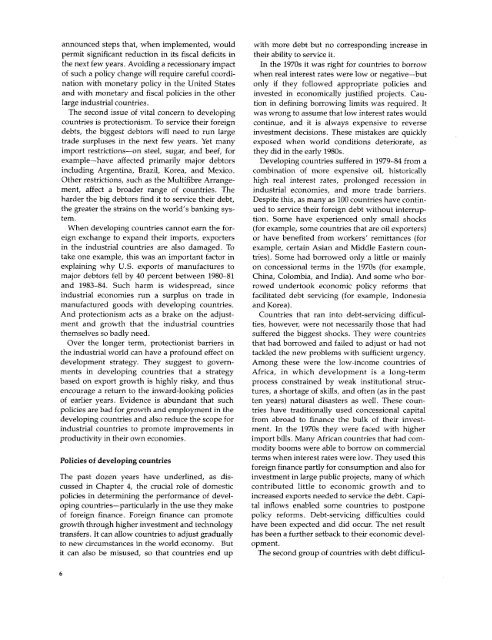World Bank Document
World Bank Document
World Bank Document
Create successful ePaper yourself
Turn your PDF publications into a flip-book with our unique Google optimized e-Paper software.
announced steps that, when implemented, would with more debt but no corresponding increase in<br />
permit significant reduction in its fiscal deficits in their ability to service it.<br />
the next few years. Avoiding a recessionary impact In the 1970s it was right for countries to borrow<br />
of such a policy change will require careful coordi- when real interest rates were low or negative-but<br />
nation with monetary policy in the United States only if they followed appropriate policies and<br />
and with monetary and fiscal policies in the other invested in economically justified projects. Caularge<br />
industrial countries.<br />
tion in defining borrowing limits was required. It<br />
The second issue of vital concern to developing was wrong to assume that low interest rates would<br />
countries is protectionism. To service their foreign continue, and it is always expensive to reverse<br />
debts, the biggest debtors will need to run large investment decisions. These mistakes are quickly<br />
trade surpluses in the next few years. Yet many exposed when world conditions deteriorate, as<br />
import restrictions-on steel, sugar, and beef, for they did in the early 1980s.<br />
example-have affected primarily major debtors Developing countries suffered in 1979-84 from a<br />
including Argentina, Brazil, Korea, and Mexico. combination of more expensive oil, historically<br />
Other restrictions, such as the Multifibre Arrange- high real interest rates, prolonged recession in<br />
ment, affect a broader range of countries. The industrial economies, and more trade barriers.<br />
harder the big debtors find it to service their debt, Despite this, as many as 100 countries have continthe<br />
greater the strains on the world's banking sys- ued to service their foreign debt without interruptem.<br />
tion. Some have experienced only small shocks<br />
When developing countries cannot earn the for- (for example, some countries that are oil exporters)<br />
eign exchange to expand their imports, exporters or have benefited from workers' remittances (for<br />
in the industrial countries are also damaged. To example, certain Asian and Middle Eastern countake<br />
one example, this was an important factor in tries). Some had borrowed only a little or mainly<br />
explaining why U.S. exports of manufactures to on concessional terms in the 1970s (for example,<br />
major debtors fell by 40 percent between 1980-81 China, Colombia, and India). And some who borand<br />
1983-84. Such harm is widespread, since rowed undertook economic policy reforms that<br />
industrial economies run a surplus on trade in facilitated debt servicing (for example, Indonesia<br />
manufactured goods with developing countries. and Korea).<br />
And protectionism acts as a brake on the adjust- Countries that ran into debt-servicing difficulment<br />
and growth that the industrial countries ties, however, were not necessarily those that had<br />
themselves so badly need.<br />
suffered the biggest shocks. They were countries<br />
Over the longer term, protectionist barriers in that had borrowed and failed to adjust or had not<br />
the industrial world can have a profound effect on tackled the new problems with sufficient urgency.<br />
development strategy. They suggest to govern- Among these were the low-income countries of<br />
ments in developing countries that a strategy Africa, in which development is a long-term<br />
based on export growth is highly risky, and thus process constrained by weak institutional strucencourage<br />
a return to the inward-looking policies tures, a shortage of skills, and often (as in the past<br />
of earlier years. Evidence is abundant that such ten years) natural disasters as well. These counpolicies<br />
are bad for growth and employment in the tries have traditionally used concessional capital<br />
developing countries and also reduce the scope for from abroad to finance the bulk of their investindustrial<br />
countries to promote improvements in ment. In the 1970s they were faced with higher<br />
productivity in their own economies.<br />
import bills. Many African countries that had commodity<br />
booms were able to borrow on commercial<br />
Policies of developing countries<br />
terms when interest rates were low. They used this<br />
foreign finance partly for consumption and also for<br />
The past dozen years have underlined, as dis- investment in large public projects, many of which<br />
cussed in Chapter 4, the crucial role of domestic contributed little to economic growth and to<br />
policies in determining the performance of devel- increased exports needed to service the debt. Capioping<br />
countries-particularly in the use they make tal inflows enabled some countries to postpone<br />
of foreign finance. Foreign finance can promote policy reforms. Debt-servicing difficulties could<br />
growth through higher investment and technology have been expected and did occur. The net result<br />
transfers. It can allow countries to adjust gradually has been a further setback to their economic develto<br />
new circumstances in the world economy. But opment.<br />
it can also be misused, so that countries end up The second group of countries with debt difficul-<br />
6

















